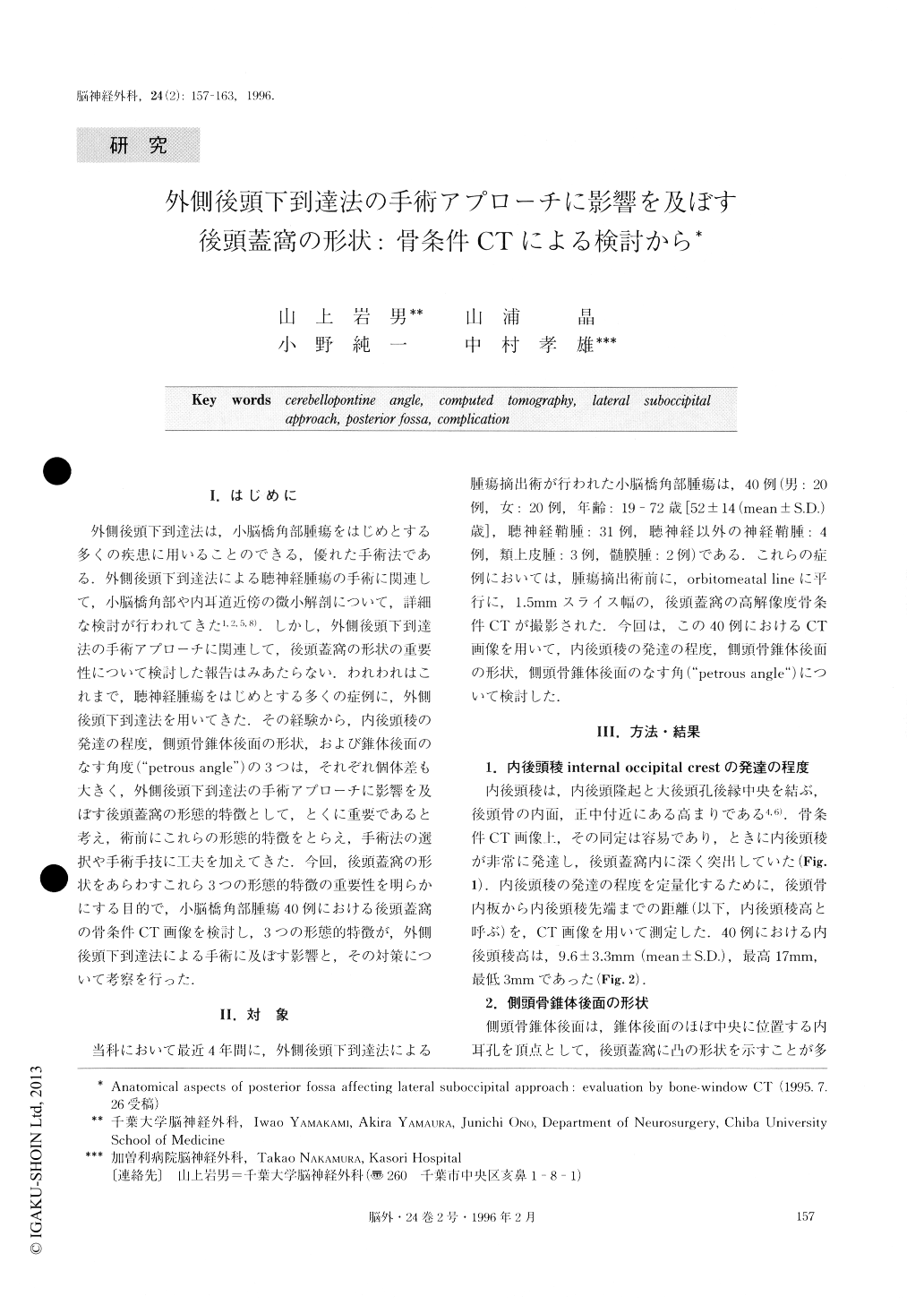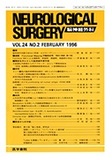Japanese
English
- 有料閲覧
- Abstract 文献概要
- 1ページ目 Look Inside
I.はじめに
外側後頭下到達法は,小脳橋角部腫瘍をはじめとする多くの疾患に用いることのできる,優れた手術法である.外側後頭下到達法による聴神経腫瘍の手術に関連して,小脳橋角部や内耳道近傍の微小解剖について,詳細な検討が行われてきた1,2,5,8).しかし,外側後頭下到達法の手術アプローチに関連して,後頭蓋窩の形状の重要性について検討した報告はみあたらない.われわれはこれまで,聴神経腫瘍をはじめとする多くの症例に,外側後頭下到達法を用いてきた.その経験から,内後頭稜の発達の程度,側頭骨錐体後面の形状,および錐体後面のなす角度(“petrous angle”)の3つは,それぞれ個体差も大きく,外側後頭下到達法の手術アプローチに影響を及ぼす後頭蓋窩の形態的特徴として,とくに重要であると考え,術前にこれらの形態的特徴をとらえ,手術法の選択や手術手技に工夫を加えてきた.今回,後頭蓋窩の形状をあらわすこれら3つの形態的特徴の重要性を明らかにする目的で,小脳橋角部腫瘍40例における後頭蓋窩の骨条件CT画像を検討し,3つの形態的特徴が,外側後頭下到達法による手術に及ぼす影響と,その対策について考察を行った.
Analyzing the bone-window CT of the posterior fos-sa, the authors investigated three anatomical aspects of the posterior fossa affecting the lateral suboccipital approach (LSA). The high-resolution 1.5mm-slice bone-window CT images of the posterior fossa in 40 patients with the cerebellopontine angle tumor were re-viewed regarding three anatomical aspects: 1) the in-ternal occipital crest (IOC), 2) the posterior surface of the petrous bone, and 3) the “petrous angle”. The IOC was sometimes prominent and protruded profoundly into the posterior fossa. The height of IOC from the in-ner table of the occipital bone was 9.6±3.3mm (max: 17mm, min: 3mm). The posterior surface of the pe-trous bone was convex to the posterior fossa in the most cases; the zenith of the prominence was the porus acusticus. The convexity of the posterior surface in the CT image was objectively evaluated by the “porus angle” made by two lines of A and B; the lineA was the posterior half of the posterior surface of the petrous bone, and the line B was the anterior half of it. The “porus angle” in 40 cases was 28± 14° (max: 61°, min: 0°) in the left side, and 28±12° (max: 56°, min: 0°) in the right side. The “petrous angle”, made by the cranial sagittal line and (the posterior half of) the pos-terior surface of the petrous bone, was 61.8±5.8° (max: 75°, min: 47°) in the left side, and 62.7±7.0 (max: 75°, min: 46°) in the right side.
In the patient with a prominent IOC, the LSA with a unilateral suboccipital craniotomy may induce the com-pression of the cerebellar hemisphere by the brain re-tractor and the prominent IOC, and develop cerebellar contusion. Such a postoperative cerebellar complication can be avoided by a large suboccipital craniotomy with the resection of the prominent IOC extending contra-laterally. The severe convexity of the posterior surface of the petrous bone, i.e. the large “porus angle”, makes it difficult to get the view of the petroclival region in the LSA. The larger is the “petrous angle” , the less cerebellar compression is necessary for the approach to the cerebellopontine angle by the LSA; the large “petrous angle” is advantageous to the approach.
The three anatomical aspects of the posterior fossa, i.e. the IOC, the posterior surface of the petrous bone (“porus angle”), and the “petrous angle”, show a con-siderable variation among individuals. Since these ana-tomical aspects affect the difficulty and the postopera-tive complication of the LSA, it can not be overlooked to evaluate them preoperatively by the bone-window CT and plan the surgical approach.

Copyright © 1996, Igaku-Shoin Ltd. All rights reserved.


